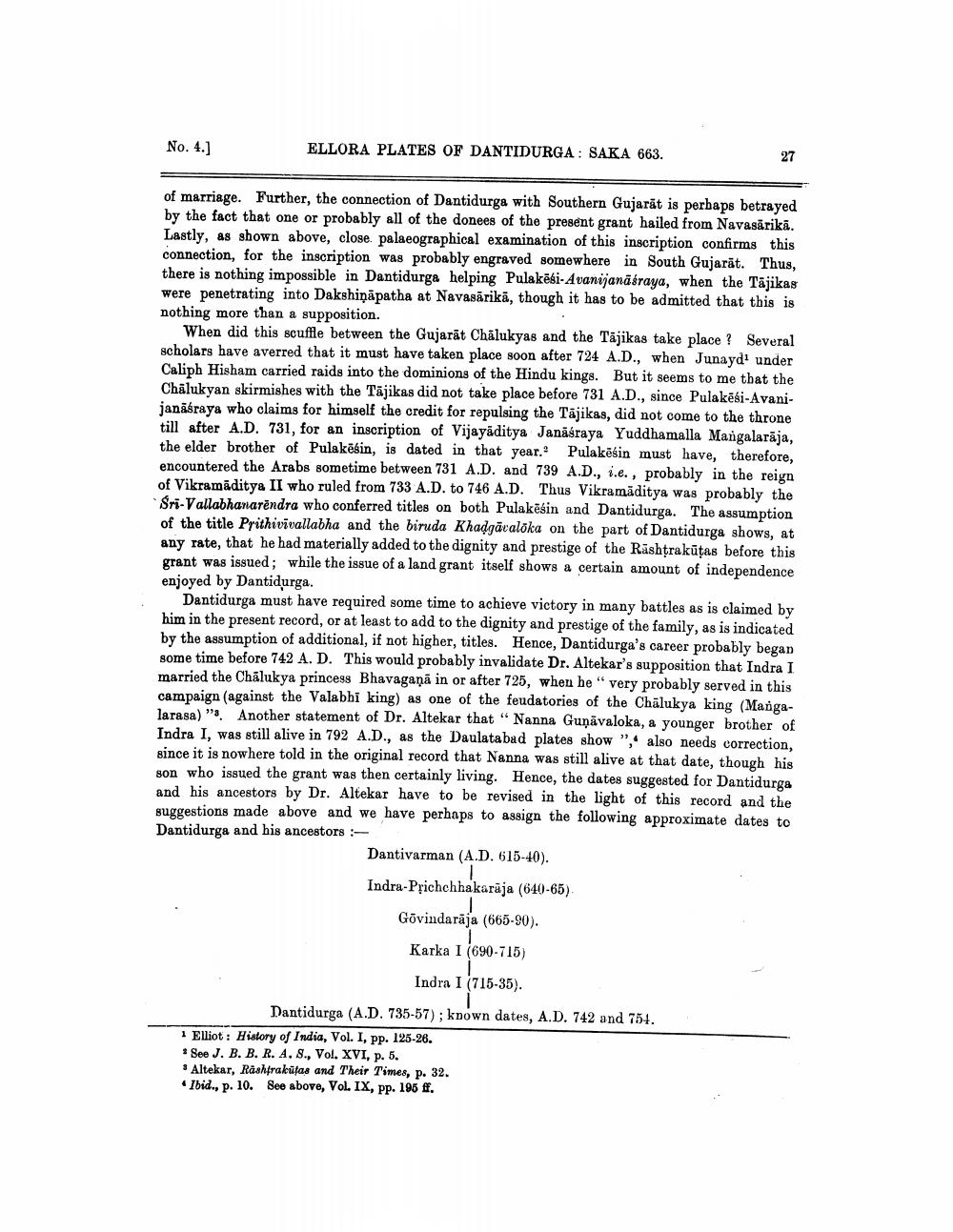________________
No. 4.]
ELLORA PLATES OF DANTIDURGA : SAKA 663.
of marriage. Further, the connection of Dantidurga with Southern Gujarăt is perhaps betrayed by the fact that one or probably all of the donees of the present grant hailed from Navasărika. Lastly, as shown above, close, palaeographical examination of this inscription confirms this connection, for the inscription was probably engraved somewhere in South Gujarat. Thus, there is nothing impossible in Dantidurga helping Pulakēbi-Avanijanäsraya, when the Tājikas were penetrating into Dakshiņāpatha at Navasārikā, though it has to be admitted that this is nothing more than a supposition.
When did this scuffle between the Gujarat Chalukyas and the Tajikas take place ? Several scholars have averred that it must have taken place soon after 724 A.D., when Junayd under Caliph Hisham carried raids into the dominions of the Hindu kings. But it seems to me that the Chalukyan skirmishes with the Tājikas did not take place before 731 A.D., since Pulakësi-Avanijanāśraya who claims for himself the credit for repulsing the Tajikas, did not come to the throne till after A.D. 731, for an inscription of Vijayaditya Janaśraya Yuddhamalla Mangalarāja, the elder brother of Pulakēsin, is dated in that year. Pulakësin must have, therefore, encountered the Arabs sometime between 731 A.D. and 739 A.D., i.e., probably in the reign of Vikramaditya II who ruled from 733 A.D. to 746 A.D. Thus Vikramaditya was probably the Sri-Vallabhanarendra who conferred titles on both Pulakēģin and Dantidurga. The assumption of the title Prithivivallabha and the biruda Khadgāraloka on the part of Dantidurga shows, at any rate, that he had materially added to the dignity and prestige of the Rashtrakūtas before this grant was issued; while the issue of a land grant itself shows a certain amount of independence enjoyed by Dantidurga.
Dantidurga must have required some time to achieve victory in many battles as is claimed by him in the present record, or at least to add to the dignity and prestige of the family, as is indicated by the assumption of additional, if not higher, titles. Hence, Dantidurga's career probably began some time before 742 A. D. This would probably invalidate Dr. Altekar's supposition that Indra I married the Chalukya princess Bhavagaņā in or after 725, when he " very probably served in this campaign (against the Valabhi king) as one of the feudatories of the Chalukya king (Mangalarasa)". Another statement of Dr. Altekar that "Nanna Gunävaloka, a younger brother of Indra I, was still alive in 792 A.D., as the Daulatabad plates show", also needs correction, since it is nowhere told in the original record that Nanna was still alive at that date, though his son who issued the grant was then certainly living. Hence, the dates suggested for Dantidurga and his ancestors by Dr. Altekar have to be revised in the light of this record and the suggestions made above and we have perhaps to assign the following approximate dates to Dantidurga and his ancestors -
Dantivarman (A.D. 615-40).
Indra-Prichchhakarāja (640-65).
Govindarāja (665-90). Karka 1 (690-715)
Indra I (715-35). Dantidurga (A.D. 735-57); known dates, A.D. 742 and 754. 1 Elliot : History of India, Vol. I, pp. 125-26. * See J. B. B. R. A.S., Vol. XVI, p. 5. : Altekar, Rashfrakūtas and Their Times, p. 32.
Ibid., p. 10. See above, VoL IX, pp. 195 ff.




